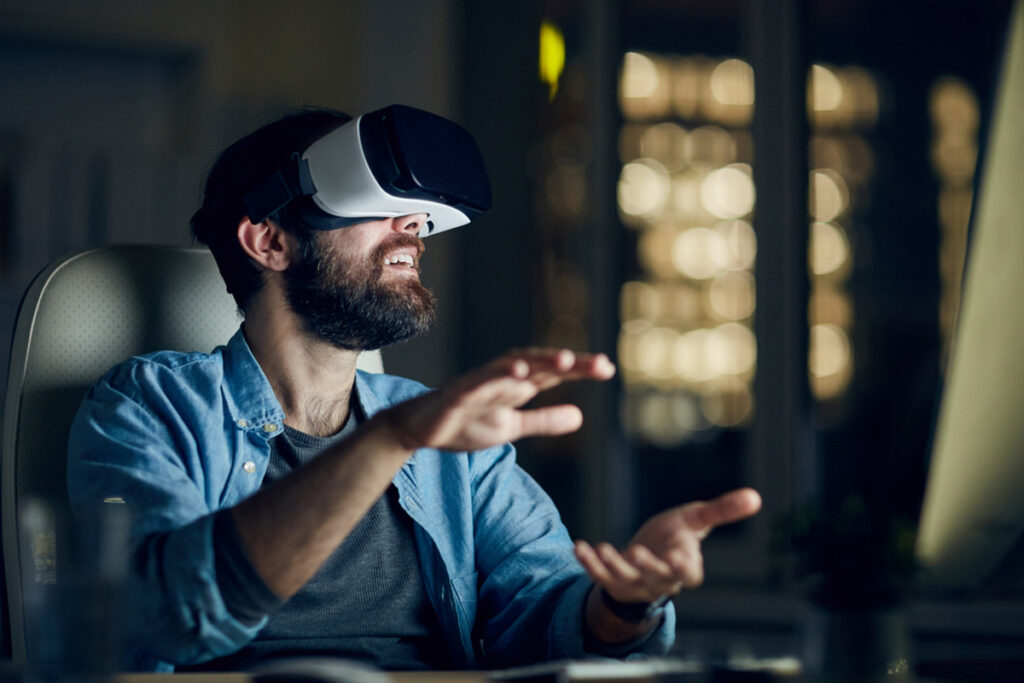When you first think of virtual reality, you might think of professional gamers, first-person shooter games, and futuristic-looking headsets. While these are all elements of VR, virtual reality is also an increasingly affordable tool for social and educational change.
Virtual reality is being utilized by organizations to boost workplace engagement and provide accessible learning for the masses. But what exactly is virtual reality and how can we incorporate it into our learning and performance support strategies?
This post will walk you through the different kinds of VR, which methods work best, and cover what you need to ask yourself before incorporating VR into your virtual learning efforts.
Virtual Learning and The Case For Augmented Reality
What exactly is VR? Virtual Reality or VR is one of the many exciting advancements in modern technology. One of WeLearn’s latest articles explores some of the leading companies and tools in the field.
Usually, through a head-set, a VR user can access and autonomously interact with a simulated environment. Because the environment is simulated, learners can experience and engage with situations that they otherwise might never have had access to.
Integrating virtual reality into your performance support or eLearning system has numerous benefits, including:
- Encouraging learners to actively engage with course content instead of being a passive learner
- A low-risk factor, ideal for safety training and potentially difficult situations
- A highly personalized quality
- Helping learners retain information through powerful visuals
There are many ways in which VR technologies can be utilized to make eLearning courses more efficient, unique, and fun. The first step is understanding the different VR learning options, and thinking about when to apply them.
The Power of Training Simulations
Augmented Reality and Training Simulations: By using VR technology, organizations can provide learners with fully immersive online training simulations.
The fact that learners can actively touch and move objects in the simulation engages them on a deeper level than a purely visual or auditory training session.
This technology is highly popular in the fields of aviation, electronics, and medicine, as it allows learners to practice highly precise tasks and act swiftly in high-risk situations.
Gamification: Marcus T. Wright, undergraduate program and communications manager for the Department of Sociology at The University of Pennsylvania speaks to the educational power of gaming in his book “Paradox of the Learning Game: The Promise and Plight of Video Games and Learning”:
“Video games bring about so much imagination, creativity, and problem-solving,” stated Wright when asked about the social and educational potential of gaming.
In his book, Wright examines two virtual reality games in particular, including:
- “Spent,” a free, online game that allows the learner to live through the eyes of someone living in poverty
- “Fair Play,” a free, downloadable game in which the learner navigates a university campus as an African-American graduate student.
Through VR, game elements can be effectively integrated into eLearning, making the learner’s experience more interactive, creative, and personal.
Personalized eLearning For A Better Learning Experience
Personalized Online Courses: VR technologies also allow eLearning platforms to customize online courses for learners:
By gaining knowledge through real-life, relevant experiences, learners will feel more personally connected to the course content, and be more likely to try their best.
The Best Approach For You: Using scenarios or hypothetical situations in your learning strategy can be highly effective.
If you are thinking about using VR to engage learners, think about the subject matter you are teaching. Augmented/Virtual Reality is often most powerful when a course’s subject matter is:
- Delicate in its subject matter, such as poverty, workplace harassment, and abuse.
- Has high risk involved, such as a medical training procedure or a complex electronic task.
- Travel related. If a learner wants to explore a faraway country and its culture,
- VR can be a cost-effective way to see the world.
Building the learner’s experience without putting them at risk is one of the most appealing elements of VR, and can help learners feel comfortable and challenged at the same time.
Moving Forward With Virtual Reality
At WeLearn, we are excited by the potential of new technologies. We believe learners shouldn’t have to choose between being engaged and having a fulfilling educational experience.
What is your experience with virtual reality? How did your perspective change after you engaged with a situation first-hand? Share your thoughts and experiences with us here at WeLearn, where together we learn.

